How to Treat Knee Pain From Home
If you are tired of dealing with painful knees and looking for a complete guide on how to treat knee pain from home, then you’re in the right place! In this article I will cover some pertinent background information about your knee joint and the factors that lead to knee pain. Then I am going to give you a full list of exercises and teach you how to properly perform each one. Additionally, I have included all of the equipment that we use with our patients in the clinic so you will be able to treat your knee pain from home.
Disclaimers and Disclosures: All information in this article is for informational and educational purposes only and should not be taken as individual medical advice. Additionally, this article contains affiliate links, meaning when you make a purchase, we make a small commission at no additional cost to you. For more information, see our full Disclaimers and Disclosures.
Overview: What causes knee pain?
Knee pain can present for a number of reasons. Maybe it started from a single incident where you tweaked your knee or maybe it started as a little ache here or there but has worsened over time. Some of the most common causes of knee pain if you are over the age of 40-50 include arthritis, meniscus tear, or following a total knee replacement. Whereas if you are under the age of 40-50 your knee pain is more likely caused by patellofemoral pain, patellar tendinitis, or an ACL injury.
Regardless of how your knee pain started though, the earlier you can start treating it, the better. Luckily, we have a standard set of exercises we give our patients when they first present to the clinic with knee pain. These exercises along with the equipment our patients use to perform them are listed below. If you choose to use the knowledge you gain in this article, then I hope it saves you time by getting an earlier start on your physical therapy journey and saves you money on copays you may not actually need to make. We’ll teach you exactly how to treat knee pain from home.
What is the normal motion of the knee joint?
The knee is a hinge joint, which simply means it is designed to straighten and to bend. The normal range of motion of the knee varies a little by age, but typically your knee should be able to straighten all the way so your lower leg and your thigh form a perfectly straight line. Conversely, you should also be able to bend your knee so that if you were lying flat on your back and slid your heel toward your butt, your heel would be within a few inches of you butt.
These motions are often restricted and/or uncomfortable when there is dysfunction in your knee. These limitations can be caused by a number of reasons, and getting rid of these limitations with the exercises below is how we get our patients started on their journey to a pain-free knee.
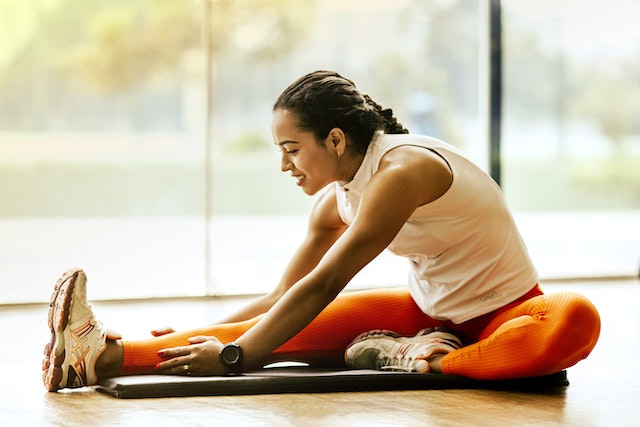
Full range of motion of the knee joint
In the image above, her right knee is demonstrating full extension range of motion and is completely straight on the ground. Her left knee is demonstrating full range of motion and is bend all the way to her butt.
What provides strength and stability to the knee joint?
The most important muscles that directly support the knee joint are the calf muscle, the hamstrings, and the quad muscle. The calf muscle is a horseshoe shaped muscle located on the back of your lower leg. Adequate strength in this muscle is required to provide support to the knee as well as the ankle. However, the calf muscle also has a propensity to get too tight, which can actually restrict the motion of these joints.
Your hamstring muscle is located on the back of your thigh and it is a long muscle that runs from your “sit bones” down the back of your thigh and behind your knee. This muscle can also become too tight and restrict motion, so it is important to work on both the strength as well as the flexibility of these muscles. The final muscle that provides direct support to the knee is the quad, which is the big muscle on the front of your thigh. You can think of the quad as a shock absorber that reduces forces that go through the knee joint, so it is crucial to get this muscle stronger in order to alleviate knee pain.
Are there other sources that provide stability to the knee?
There are several muscles that indirectly provide stability and support to the knee joint. The most important of these muscles are the gluteus maximus and the gluteus medius, collectively called your glutes and more commonly known as your butt muscles. Your gluteus maximus works in concert with your quad muscle to straighten your entire leg and therefore helps with activities such as standing up from a chair and going up stairs. Both of these activities can be pretty uncomfortable when you have knee pain, so the more we can strengthen the gluteus maximus, the more it will help the knee.
Your gluteus medius, on the other hand, helps to prevent your knee from collapsing inward toward your other knee when you are doing activities such as walking, jogging, and going down stairs. I like to say this is similar to the alignment on your car. If the wheels on your car are out of alignment, then it can create a wear pattern on your tires and they won’t last as long. Keeping your gluteus medius strong will help to create good alignment of your knee joint, which will help prevent wear patterns from developing.
These muscles become even more important as we begin to transition our patients back to functional activities such as those described above, and therefore are targeted later in our treatment regimen and will help prevent knee pain from returning.
What’s the process for how to treat knee pain from home?
Given the above information, the most important things to do initially in order to fix knee pain are to restore normal motion and flexibility to the knee joint. Then you want to start strengthening the muscles that directly support the knee. This should all be started in a non-weightbearing (lying down) position, which is least likely to aggravate the knee (or which takes the most pressure off the knee). Once these exercises are mastered, which is usually a few days to a week, then we progress our patients to weight-bearing (standing up) exercises. The weightbearing exercises are essential for further strengthening all of the muscles in the legs, as well as returning to functional activities such as walking, running, and going up and down stairs.
As a physical therapist, it is always my goal to tailor an exercise program to my patient’s specific knee condition and individual deficits. If I can be more specific when creating this program for an individual, then we generally will have better and quicker outcomes. You can explore our condition specific knee pain pages for how we diagnose and treat each of these conditions for the knee.
With that being said, even if you do not know what is causing your knee pain, there are still things you can do to help relieve it. With our patients we know that restoring motion to the knee joint, improving flexibility and strength, and reducing inflammation is what will lead to reduced pain and improving functional ability. The exercises and treatments we use to accomplish these goals are listed below. We also always get the question “where can I buy the equipment needed to help treat my knee pain?”. For convenience, we have included links to our favorite pieces of equipment for each exercise. Even if you know how to treat knee pain from home, it’s just as important to have the right equipment to get the job done!
Best exercises for treating knee pain from home
Phase 1 exercises: How to treat knee pain from home (first 1-2 weeks perform all exercises, in order, 1-2 times per day)
Whether you have had ongoing knee pain for a while now, or your knee pain just began, phase one is where we start our patients. This includes non-weight bearing exercises to start the process of reducing inflammation, restoring motion, and increasing muscle activation. We have our patients perform these exercises one to two times per day, every day.
Once the pain starts to improve and/or the patient has mastered these exercises, then we progress them to phase two. Early in treatment, most people respond well to using an ice pack and a TENS unit for reducing inflammation and for pain control, we included our favorites in the “essential equipment” below.
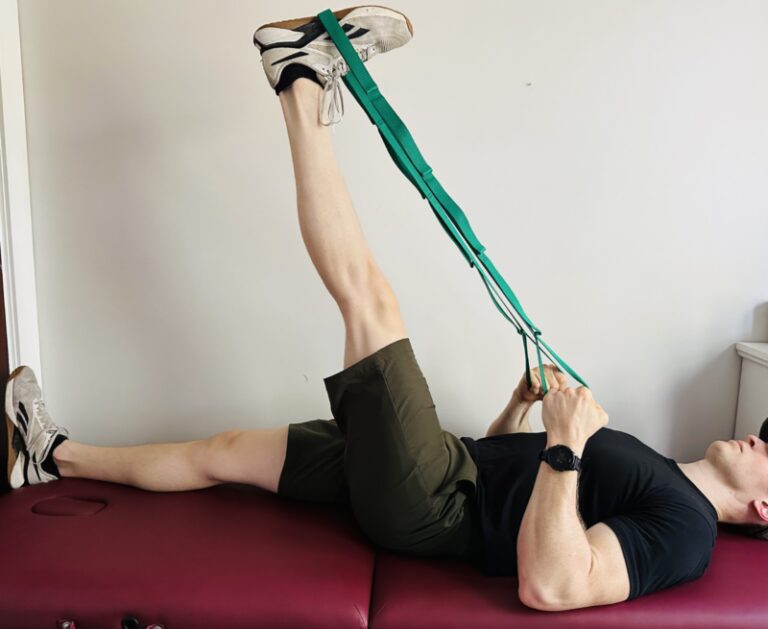
#1 Hamstring Stretch
Start by lying on your back. Place the strap around the middle of your foot and then pull on the strap with both arms to lift your leg straight off of the table until you feel a stretch down the back of your leg.
Hold this stretch for 20 seconds and perform 5 times
The best strap for this exercise can be found in the link below.
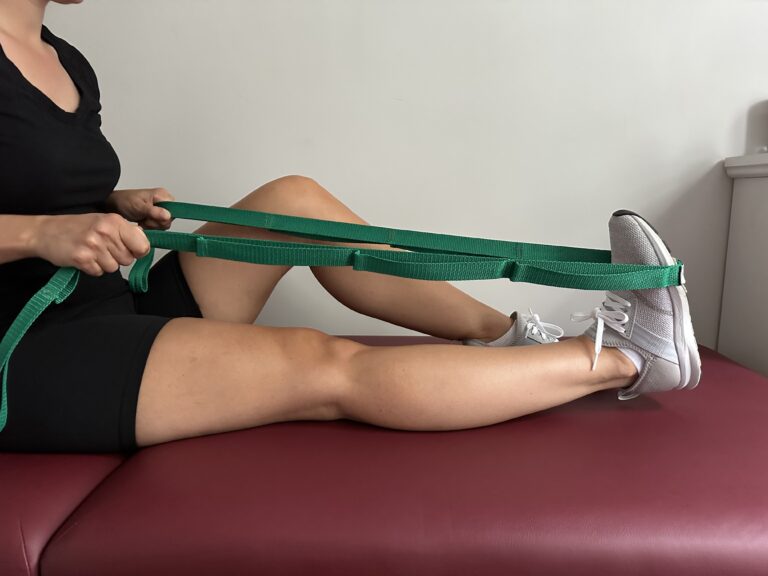
#2 Calf Stretch
Start by lying on your back. Place the strap around the ball of your foot and then pull on the strap with both arms, pulling your toes toward your nose. Keep your leg flat on the floor. You should feel a stretch down the back of your calf.
Hold this stretch for 20 seconds and perform 5 times
The best strap for this exercise can be found in the link below.
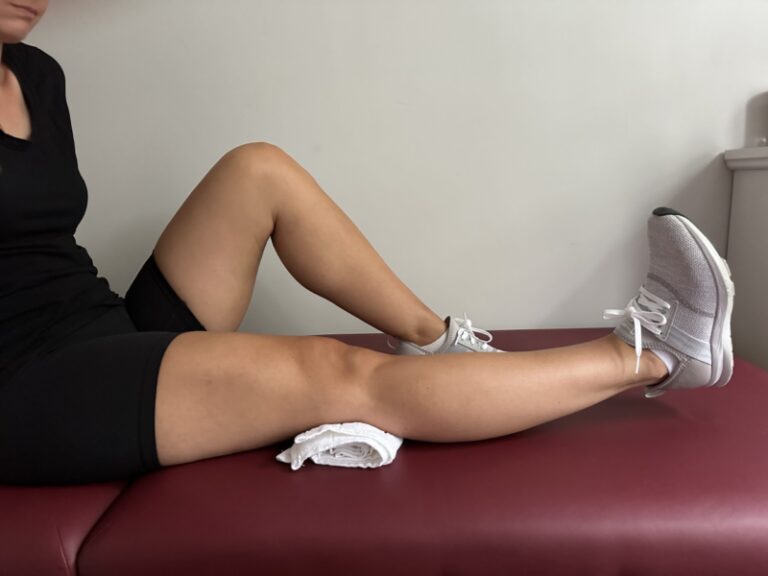
#3 Quad Set
Start by lying on your back and place a small towel roll behind your knee. Actively tighten the muscle on the front of your thigh by pushing the back of your knee into the towel roll, trying to flatten it out. You should feel your quad muscle tighten.
Tighten for 3 seconds and perform 20 times
Just roll up a towel or use a very small cushion/pillow to provide some support and cushioning behind the knee.
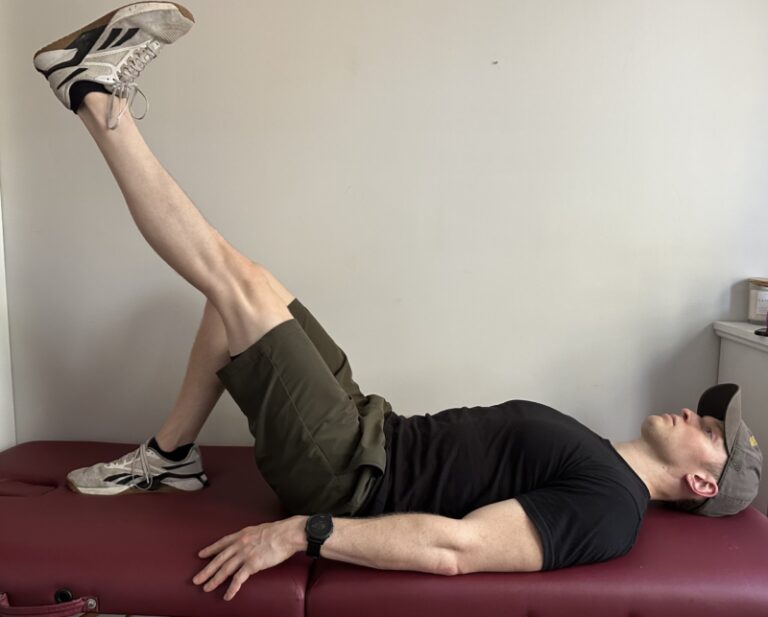
#4 Straight Leg Raise
Start by lying on your back with your opposite knee bent. Tighten your thigh muscle on the straight leg and lift it straight up until it is parallel to the opposite thigh, then slowly lower it back to the start position and repeat.
Perform 10 repetitions and then rest for 30 seconds. Perform 2 sets.
The best foam mat or massage table to lie on for this exercise can be found in the link below.
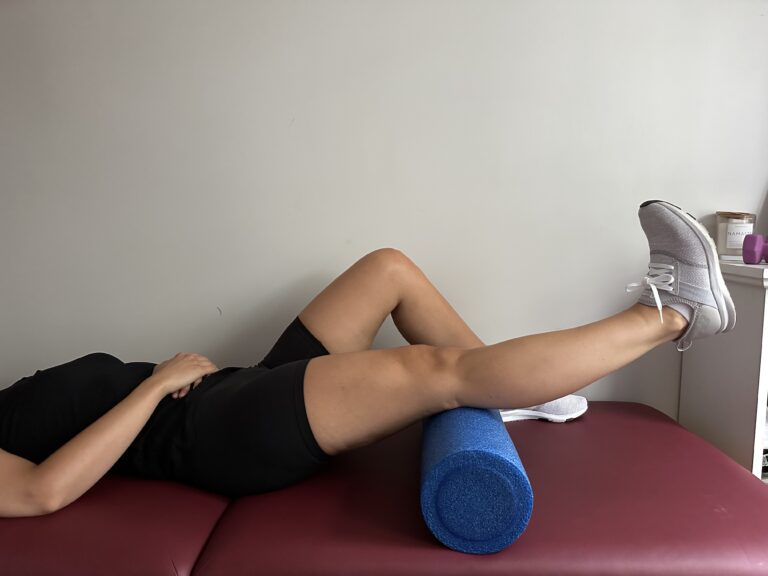
#5 Short Arc Quad
Start by lying on your back with your opposite knee bent. Place a bolster behind your involved knee. Keep the back of your knee on the bolster and kick your heel off the table until your leg is straight, slowly lower back to the start position and repeat.
Perform 15 repetitions and then rest 30 seconds. Perform 2 sets. Add a light ankle weight when this gets easy.
The best bolster and ankle weights for this exercise can be found in the links below.
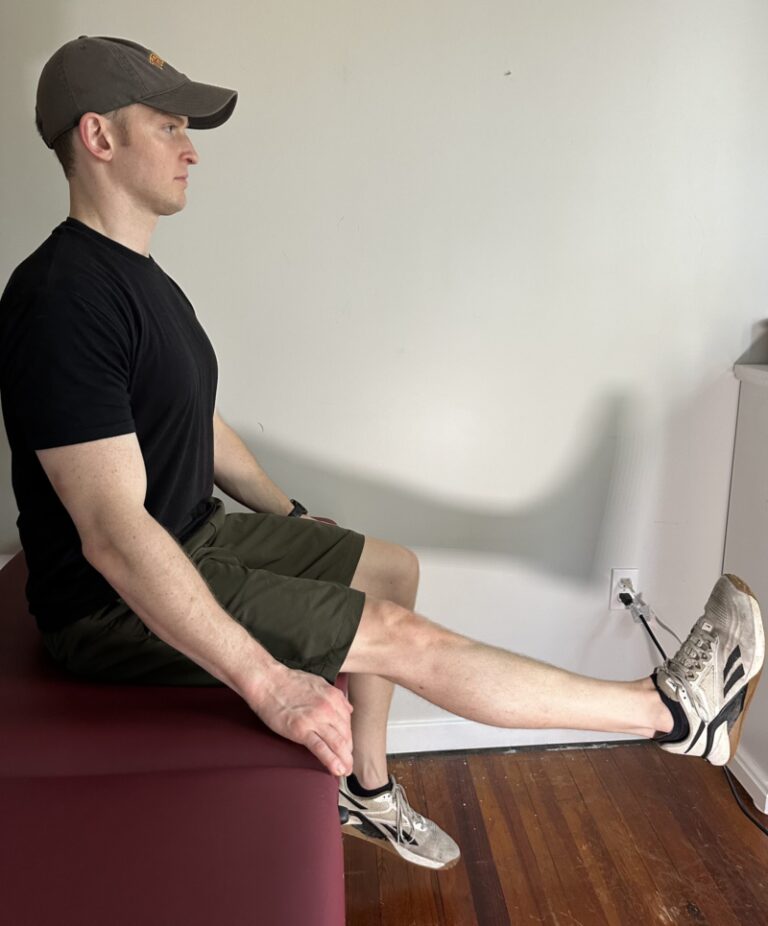
#6 Long Arc Quad
Start by sitting in a chair or on the side of your bed with your legs dangling. Slowly and controlled, kick your leg straight out and tighten the muscle on the front of your thigh. Lower back to the start position and repeat.
Perform 15 repetitions and then rest 30 seconds. Perform 2 sets. Add a light ankle weight when this gets easy.
The best ankle weights for this exercise can be found in the links below.
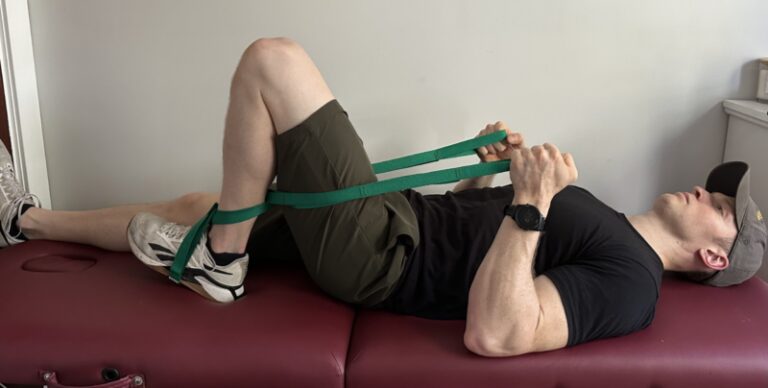
#7 Heel Slides (assisted)
Start by lying on your back with your opposite knee bent. Place the involved leg on a slide board and the strap around the middle of your foot. Pull on the strap to slide your heel toward your butt until your knee is bent. You should pull until you feel a tolerable stretch around your knee.
Hold this stretch for 10 seconds and perform 10 times
The strap for this exercise can be found in the link below.
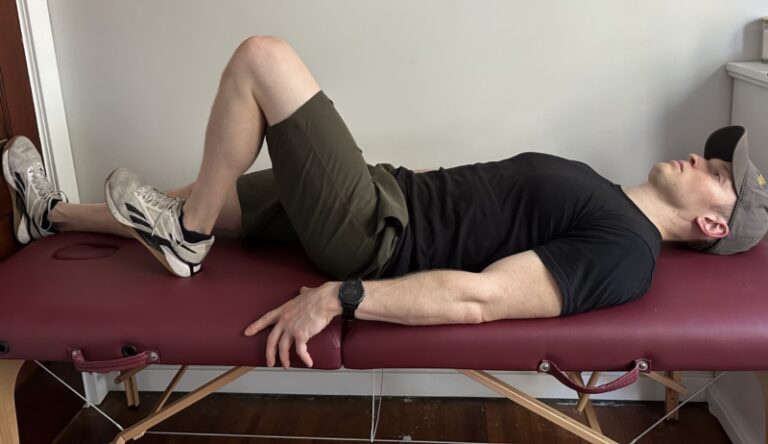
#8 Heel slides (active)
Start by lying on your back with your opposite knee bent. Place the involved leg on a slide board and then bend your knee by sliding your heel toward your butt. Bend as far as you can until you feel a tolerable stretch and then slowly return to the star position and repeat.
Perform 15 repetitions and then rest for 30 seconds. Perform 2 sets.
The slide board for this exercise can be found in the link below.

Essential Equipment
Phase 2 exercises: How to treat knee pain from home (weeks 3-4 perform all exercises, in order, once per day)
Now that we have started to restore range of motion to the knee and strength to the muscles that directly support the knee, it is time to improve stability and initiate weight bearing exercises. This phase is crucial for the transition back to more functional activities such as walking and going up and down stairs. It is still important though, to continue to monitor and prevent swelling and inflammation from returning or worsening.
The best way to do this is to slowly progress the following exercises and continue with a quality ice pack and TENS unit. Most people are ready for the phase two exercises within a week or two, but it’s important to progress based on how you feel. At this point, we have our patients continue with the hamstring stretch, the long arc quad, and the heel slides from above and then add in the exercises below.
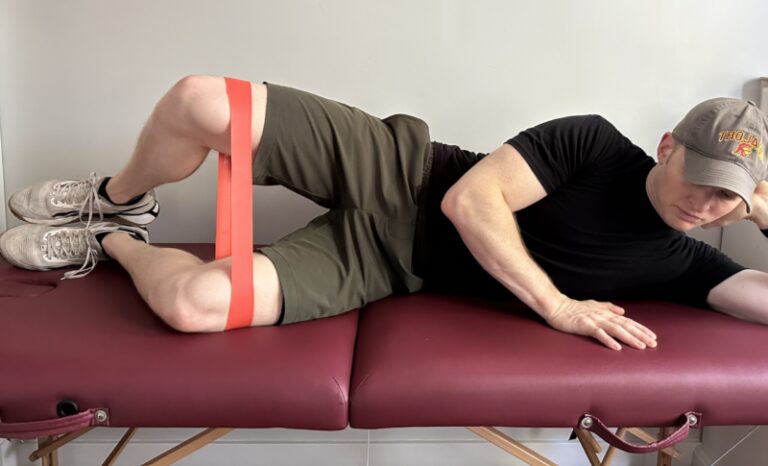
#1 Side-lying Clams
Start by lying on your side with a resistance band wrapped just above your knees. Keep your feet together and spread your knees apart, without letting your hips rolls back. Keep tension on the band for 3 seconds and then control back to the start position and repeat. Perform this exercise on both sides.
Hold for 3 seconds and perform 15 times. Increase resistance band tension when this gets easy.
The best resistance bands for this exercise can be found in the link below.
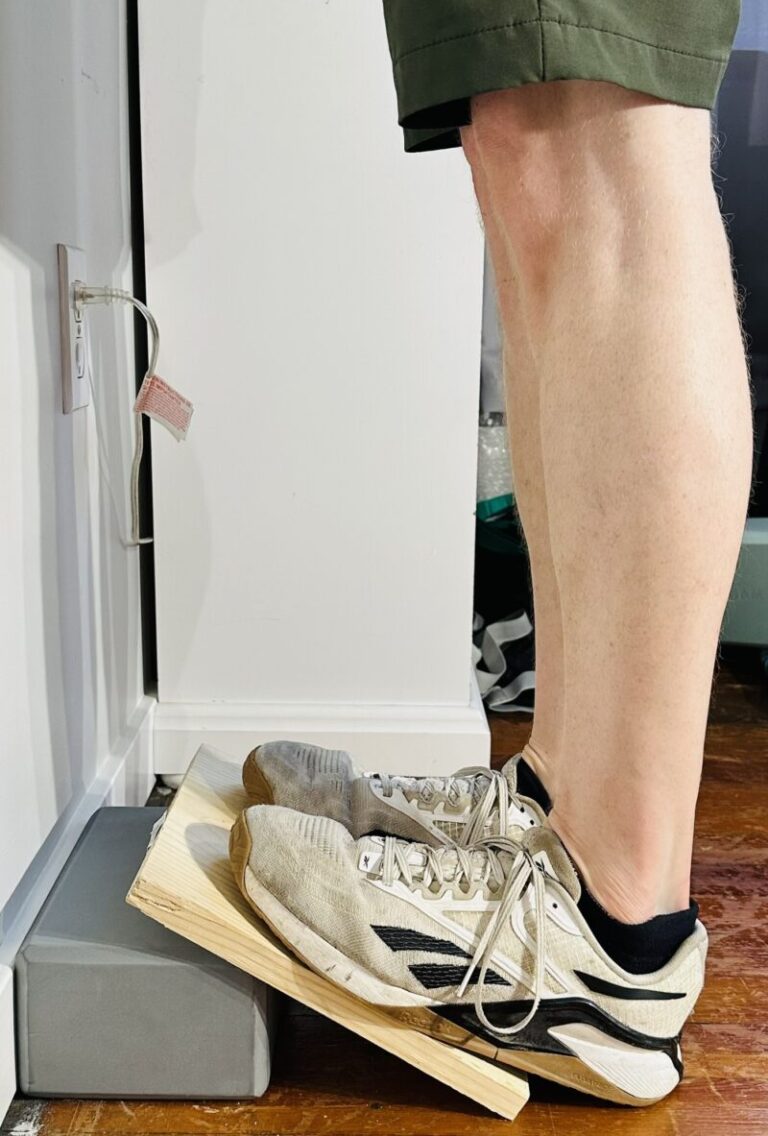
#2 Standing Calf Stretch
Start by standing with both feet on the wedge and your knees straight. Keep your whole body straight and lean forward until you feel a stretch in the back of both of your calves. Make sure you have a counter or something sturdy to hold on to and to not lose your balance.
Hold this stretch for 20 seconds and perform 5 times. You can adjust the height of the wedge to feel a stronger stretch.
The best wedge for this exercise can be found in the link below.
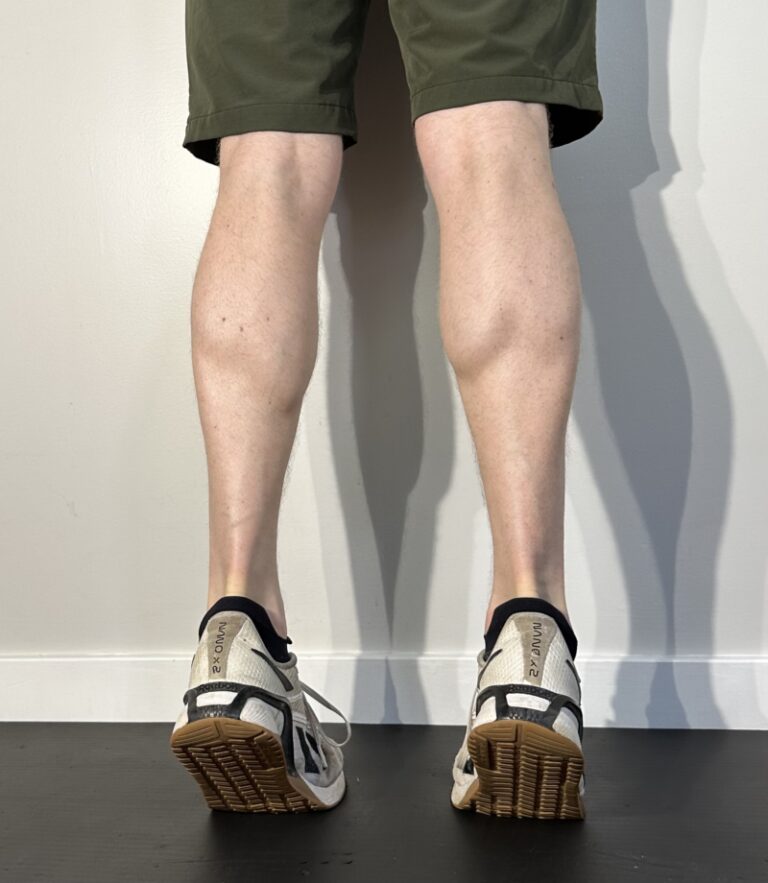
#3 Heel/Toe Raises
Start by standing at a counter with both feet flat on the floor. Shift forward onto the balls of your feet and raise your heels off the ground, then return to the start and shift back onto your heels and raise your toes off the ground. Alternate back and forth raising your heels and then your toes in a controlled manner.
Forward and back counts as 1 repetition. Perform 15 repetitions and do 2 sets.
No equipment is needed for this exercise!

#4 Cone Step Overs
Start by standing at a counter with both feet on one side of a cone. Step one foot directly over top of the cone to the other side and then step the other foot directly over top of the cone so both feet are now on the opposite side of the cone as when you started. Over and back counts as one repetition, think of high knees as you lift your foot off the ground.
Perform 20 repetitions.
The best targets to step over for this exercise can be found in the link below.
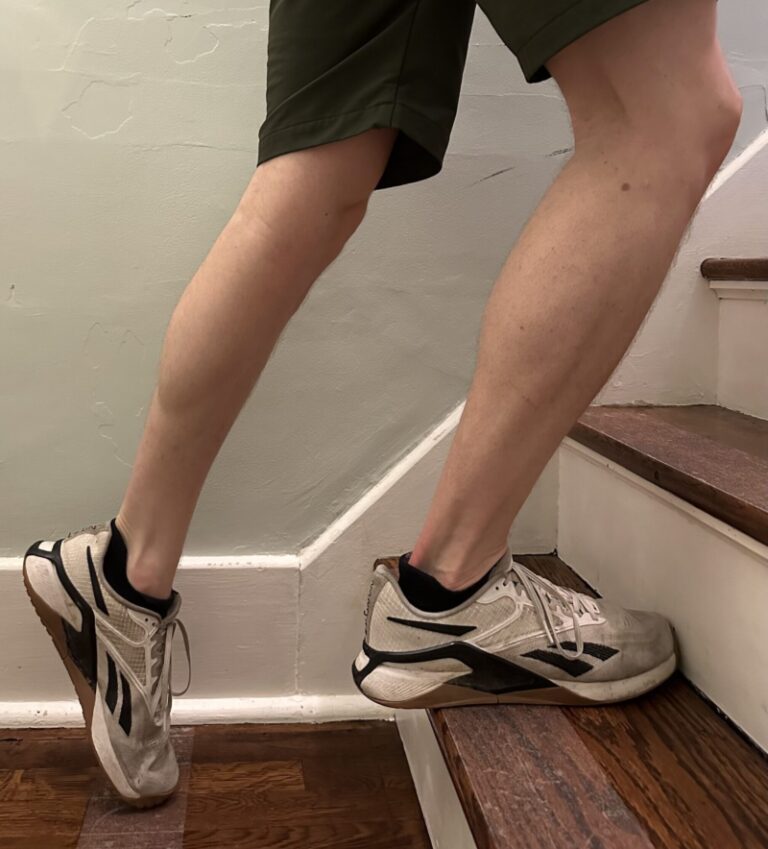
#5 Step Ups
Start by standing in front of a small step with a counter to hold on to by your side. Step your left foot up onto the step, followed by your right foot. Then step your left foot back down to the start position, followed by your right foot. This counts as one repetition.
Perform 10 repetitions leading with your left leg and then 10 repetitions leading with your right leg. Perform 2 sets on each side. Increase the height of the step when this gets easy.
The best stepper for this exercise can be found in the link below.

#6 Lateral Step Overs
Start by standing in front of your counter with a small stepper set up on your left side. Step up onto the step with your left leg, followed by your right leg. Then step down to the other side of the step leading with your left leg and followed by your right leg. Then return to the start position and this counts as one repetition.
Perform 10 repetitions and then rest 30 seconds. Perform 2 sets. Increase the height of the step when this gets easy.
The best stepper for this exercise can be found in the link below.

#7 Single Leg Balance
Start by standing in front of a counter with both hands on the counter and both feet on the ground. Raise one foot off the ground and then raise both hands off the counter. The goal is to balance in this position without holding on, but use your hands to make small corrections as needed. Then repeat on the other side. Perform the same exercises standing on a foam pad when this gets easy.
Hold this balance for 15 seconds and perform 4 times on each side, alternate sides after each repetition.
The best foam balance pad for this exercise can be found in the link below.
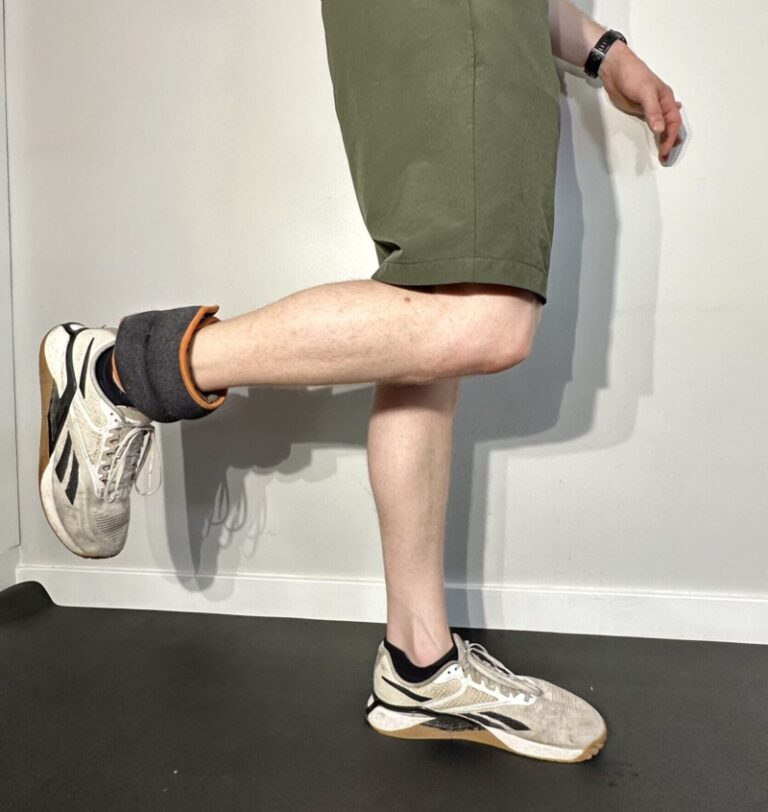
#8 Standing Hamstring Curl
Start by standing in front of your counter with a small ankle weight on each ankle. Slowly bend your knee and raise your foot off the ground until your lower leg is parallel to the ground. Try not to let your knee drift forward, and then return to the start position and repeat.
Perform 15 repetitions and then rest for 30 seconds. Perform 2 sets.
The ankle weights for this exercise can be found in the link below.

Essential Equipment
1. Stretching Wedge
2. Ankle Weights
3. Foam Balance Pad
4. Resistance Bands
5. Stepper
6. TENS unit
7. Ice pack
8. Cone target
Phase 3 exercises: How to treat knee pain from home (weeks 5-6 perform stretches 1x/day and all other exercises 3x/week)
Once our patients have progressed through the weight bearing exercises of phase two and start to regain confidence in their knee, it is time to transition to the final phase of treating knee pain. It is at this time that we work on advanced strengthening and stability exercises for the knee in order to have a full return to pain-free daily activities as well as prevent the return of their symptoms.
We have our patients continue the hamstring stretch, the long arc quad, the heel slides, the standing calf stretch, the step ups, and the lateral step overs from above. These exercises are performed once per day, and then the exercises from below are added to the routine three times per week, or every other day.
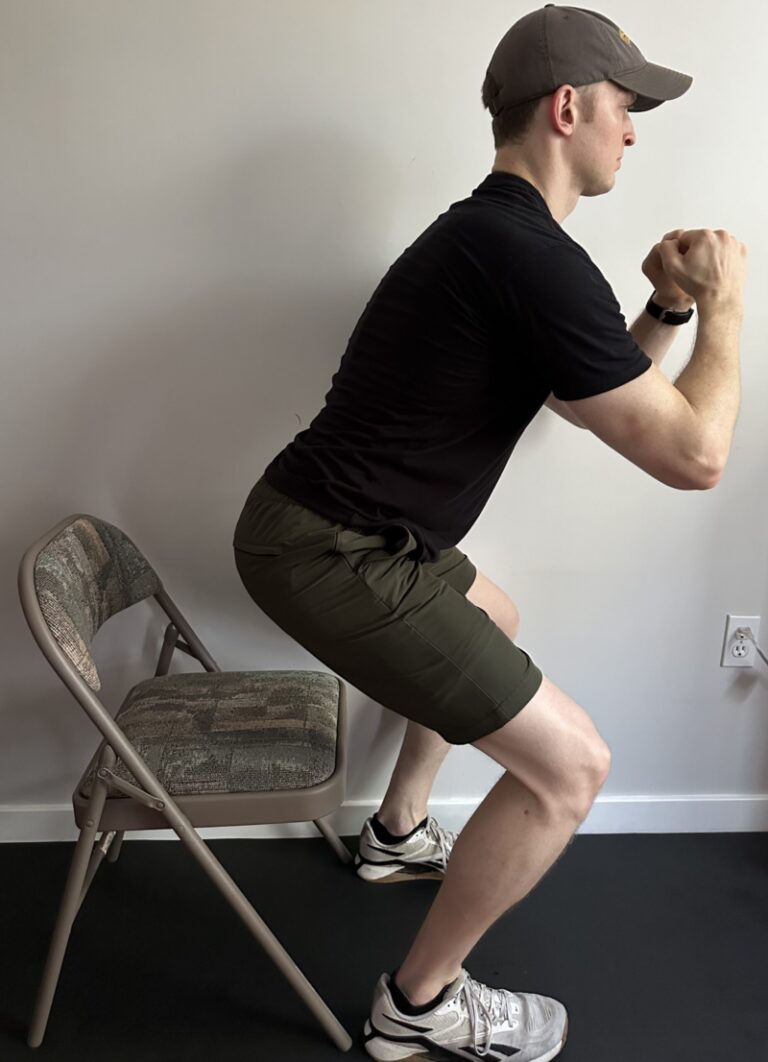
#1 Sit to Stand
Start by standing in front of a chair with your feet hip width apart. Slowly lower your butt to the chair so it just touches it but you don't sit in it, and then stand back up to the start position and repeat. Start with a high chair or with a few pillows on it to raise your target, and then remove pillows to lower the target as it gets easy.
Perform 10 repetitions and then rest for 30 seconds. Perform 2 sets.
The best foam pad to be used as a target for this exercise can be found in the link below.

#2 Step Downs
Start by standing with your affected leg on a small step and holding on to a railing for balance. Slowly bend your knee and lower the opposite heel to the ground. I like to tell my clients, pretend there is a potato chip on the ground that you want to touch with your heel, but not crack, and then stand back to the start position and repeat.
Perform 10 repetitions and then rest 30 seconds. Perform 2 sets. Add height to the step when this gets easy.
The best stepper for this exercise can be found in the link below.
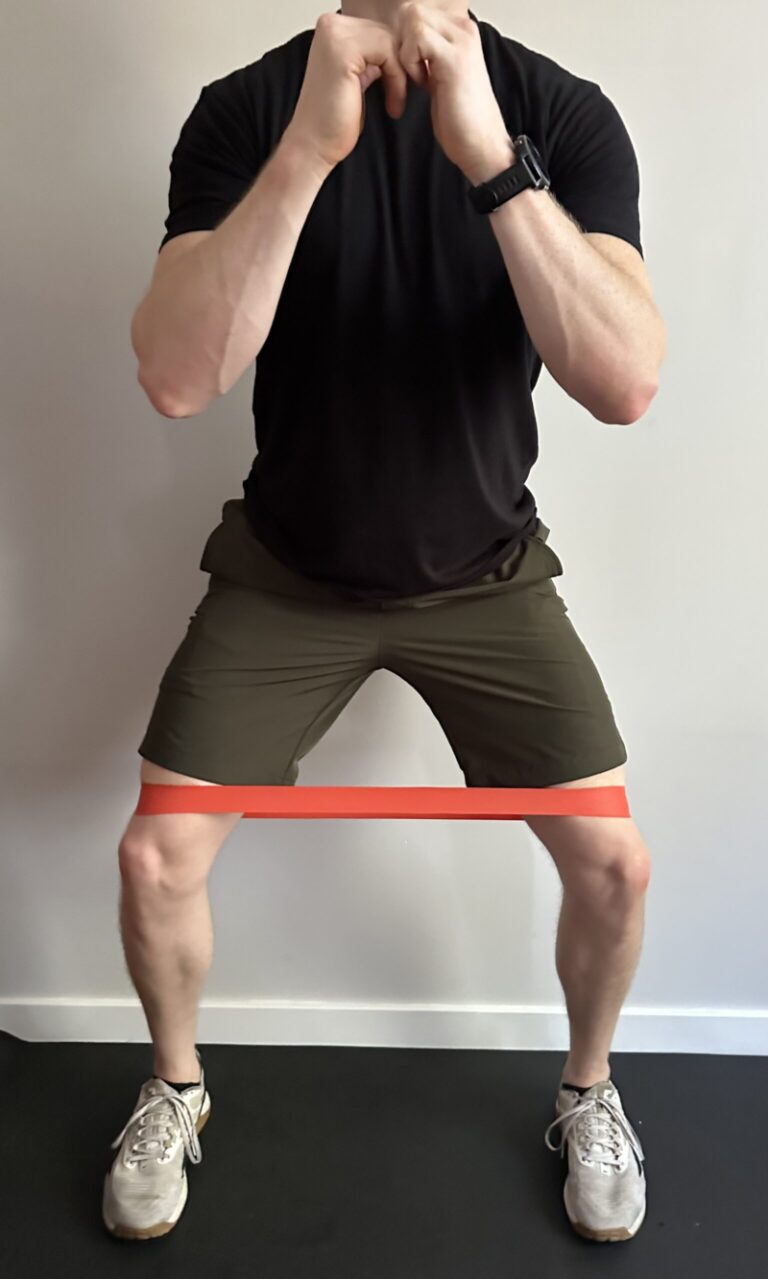
#3 Sidesteps with a band
Start by standing with a resistance band wrapped just above your knees. Keep your feet wide and your knees apart so they are aligned right over top of your ankles. Take wide, but small steps to one side so there is always tension on the band.
Perform 15 steps going one direction and then repeat in the opposite direction. Increase the resistance band when this gets easy.
The best resistance bands for this exercise can be found in the link below.
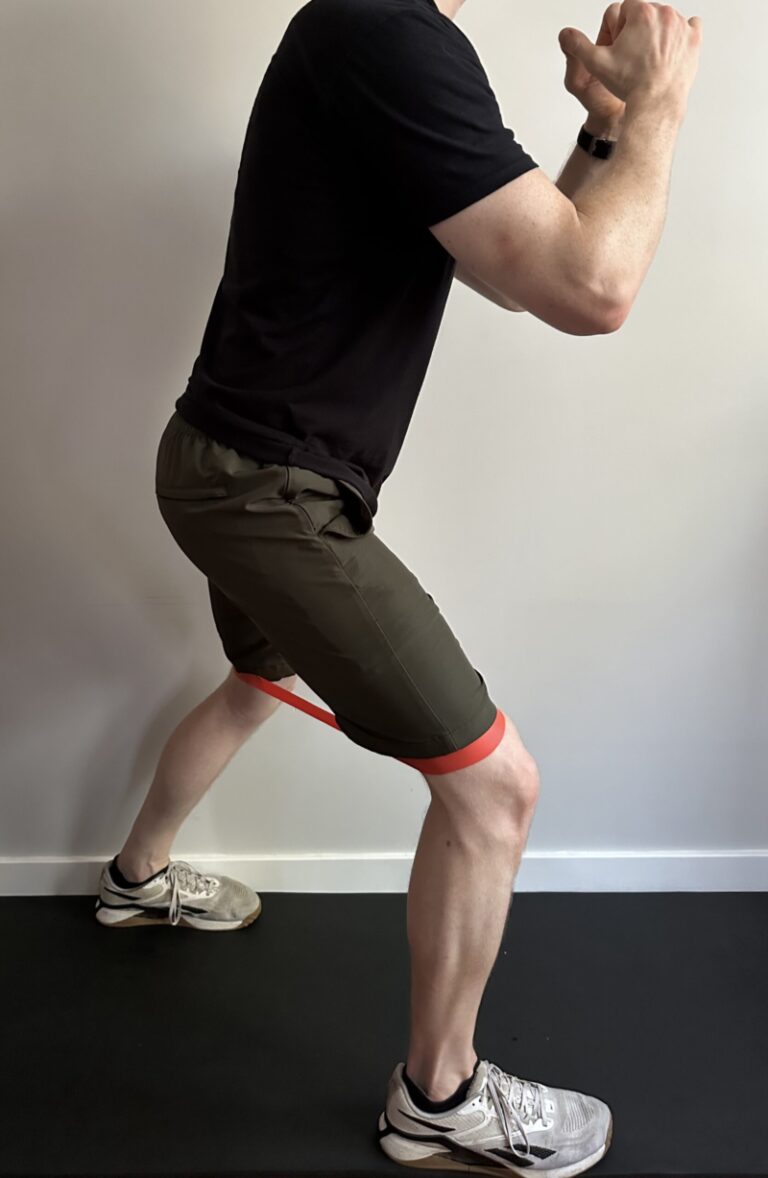
#4 Monster walks
Start by standing with a resistance band wrapped just above your knee. Keep your feet wide and your knees apart so they are aligned right over top of your ankles. Take small steps forward keeping your knees and feet wide with tension on the band. Then do the same thing in reverse.
Perform 15 steps going forward, and then 15 steps in reverse. Increase the resistance band when this gets easy.
The best resistance bands for this exercise can be found in the link below.
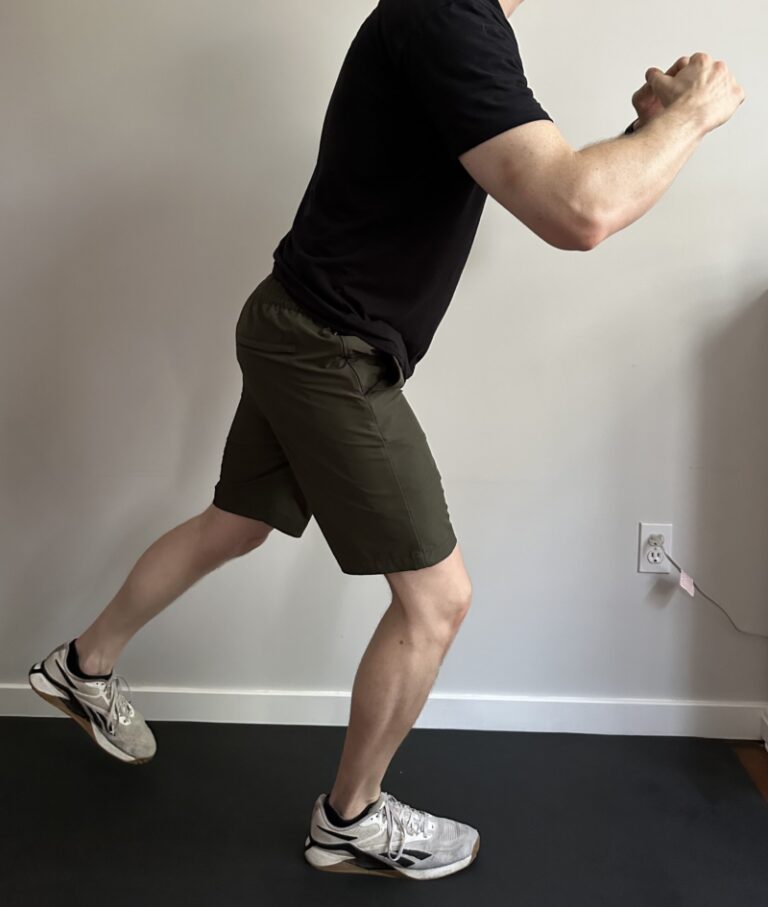
#5 Step Holds
Start by standing with both feet together. Pretend there is a large puddle in front of you and the goal is to take a big step with one of your feet to get over the puddle without getting your feet wet. Step on to that foot and land with a slight bend in your knee and balance in that position for 3 seconds. Return to the start position and repeat. Step onto a foam pad for a balance challenge when this gets easy.
Perform 10 repetitions and then rest for 30 seconds. Perform 2 sets.
The best foam balance pad for this exercise can be found in the link below.

Essential Equipment
1. Stretching Wedge
2. Ankle Weights
3. Foam Balance Pad
4. Resistance Bands
5. Stepper
6. TENS unit
7. Ice pack
8. Massage gun
Professional tips we give our patients for the knee pain exercises
You should now have a really solid understanding of how to treat knee pain from home. However, after years of treating patients with knee pain, I think there are a few more tips and tricks that will help you on your way.
The stretching exercises should feel like a strong stretch in the target muscle, which can be mildly uncomfortable if you are not used to stretching, but it should not reproduce your knee pain. The strengthening exercises should be mostly pain-free but it is normal to sometimes have mild discomfort as you try to get these tissues strong again.
The discomfort should always be tolerable, not getting worse as you do the exercises, and should go away once you are done with the exercises. If you feel the pain worsening or if it does not go away, this is your body telling you it has had enough and that exercise should be stopped or reduced in difficulty. Remember that all of the sets, reps, and weights are just recommendations and can be adjusted based on how you feel to make it harder or easier. As always, it is your body and no one knows it better than you do.
You now know how to treat knee pain from home and you have the resources to accomplish it. Sometimes I wish there was a quicker and easier way to solve the aches, pains, and injuries that arise in our bodies. Maybe one day we’ll figure it out and if you find the answer before us, feel free to share it with us and we’ll all become millionaires together. Until then, I feel confident that the exercises and treatments above are the most efficient way to get rid of knee pain and get back on the path to recovery.